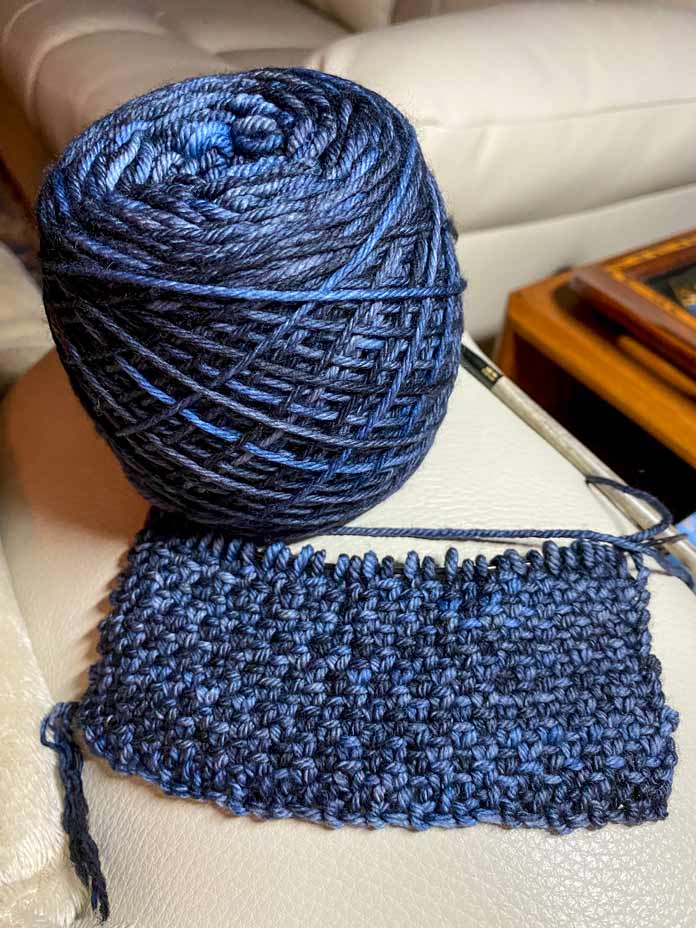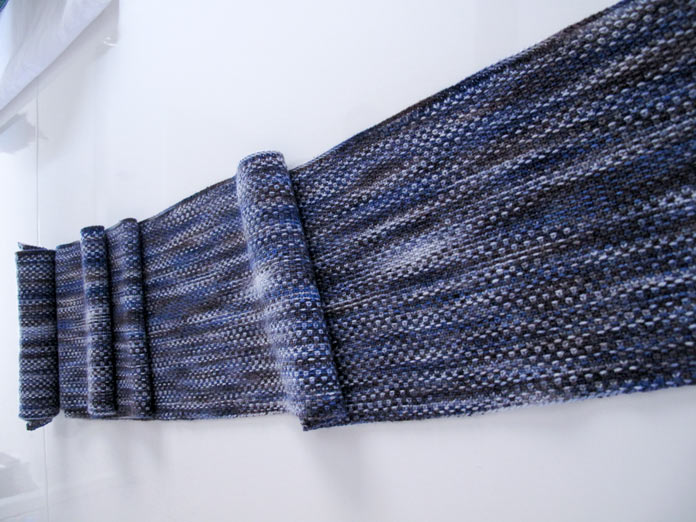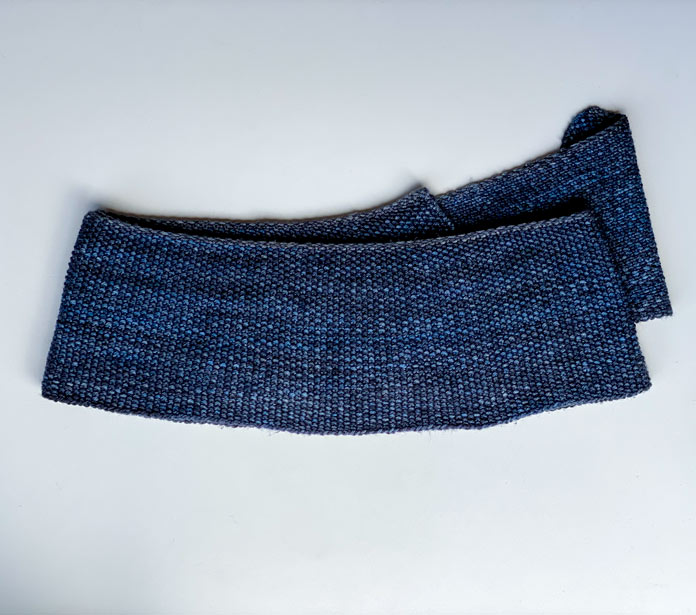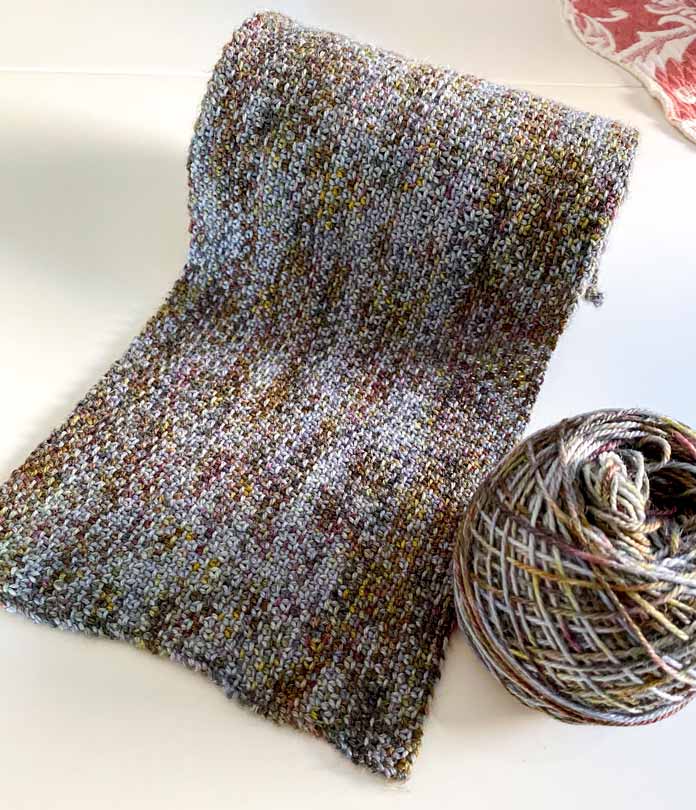As I blocked the linen stitch scarf I knitted for my friend Steve this summer, I contemplated how luxurious this knitted stitch pattern can look, yet it’s not a common one. The linen stitch is best highlighted in rectangular or square knits using variegated yarn. So think of scarves, placemats, and blankets.

My swatch for checking how the colour variegation will play out.
In knitting, the linen stitch is a very meditative stitch, where the first and second rows will seem awkward, almost like you’re fighting the instinct to knit or purl. But before you know it, it too becomes natural and mindless. So perfect for unwinding together with your ball of yarn at the end of the day.
In all, I’ve knitted four scarves in linen stitch over ten years, using the free pattern Cerus Scarf by Hilary Smith Callis, which I had come across by chance. It’s knitted lengthwise for maximum appeal.
The first linen stitch scarf I knitted was for my son when he was off to university in 2014. Notice the smoother transition of shade variation throughout the scarf as the yarn isn’t heavily variegated, but rather lightly so. Thankfully, he loved it too. As you may know, I always let the recipient choose the yarn color so it’s their favorite. Thumbs up to that! Next time, I will use a larger needle size when knitting with similar 100% pure wool, as this yarn tended to pull the stitches together after washing. Still, it’s gorgeous.
The thing to remember with the linen stitch is that it will always require at least 2 and sometimes 3 needle sizes larger than what is recommended for the yarn weight. So swatching first is paramount!

The slight color variation offers a smoother, more uniform look to the finished scarf.
The second linen stitch scarf I knitted was for Steve, using a sock yarn with more variegation. The greater the color variation, the more interesting the overall look.

Steve’s first scarf measures 69” x 7”, casting on 355 sts.
The third one I knitted was for my DH in a variegated sock yarn of only one color, which varied in shade, not color. Yet another ‘look’ to the overall scarf.

Dear Hubby’s scarf was made with yarn in a light-to-deep blue colorway.
Here’s a photo of the back of the linen stitch. I also love that it’s reversible, with an equally interesting look, making the back of the work as interesting—or might I say more interesting—than the front! Oh joy!

Here’s what the back of the linen stitch scarf looks like. The back is just as interesting as the front.
Fast forward to the winter of 2024-25, and I noticed how well-used Steve’s scarf had been since 2015. He was well overdue for a new one. And again, I had him choose the colorway from a selection of colors I knew he could be interested in. This sock yarn was a fingering-weight blend of 32% nettle fiber and merino wool. So soft. I’m in heaven the whole time I’m knitting up the scarf.

Steve’s second linen stitch scarf
Fun Fact: when I packaged Steve’s scarf to gift to him, I wrote a little note that included the part of the yarn label for fiber content, care instructions, and on the blank side of the label, I wrote: 499 stitches across each row x 88 rows = 43, 912 loving stitches, (remember, this is fingering weight yarn); not to make him feel bad about it, but it’s an interesting fact where every stitch was knitted with joy. This scarf measured 76” x 7”.
Another idea for using the linen stitch is in a project we featured in A Needle Pulling Thread magazine, the Friendship Blanket Shrug. The wonderful Jacqueline Grice created it. The bonus of this project is that it uses leftover yarn. Can you imagine diving into your leftover stash of the same weight yarn?! Depending on the stash, completing it could take longer unless you have a large amount. It’s one of those knits-up-as-you-accumulate-leftover-yarn projects…

Friendship Blanket Shrug from A Needle Pulling Thread Magazine Issue Spring 2016, worked up in Linen Stitch using leftover yarn of the same weight.
Eventually, I’d like to try knitting placemats in a fingering-weight cotton yarn using the linen stitch. And perhaps if I find the right worsted-weight yarn, a throw. So many possibilities! I hope you’ll give it a try. Until next time, happy knitting.
